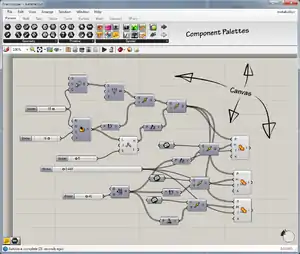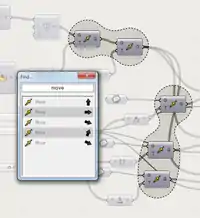Grasshopper 3D
Grasshopper is a visual programming language and environment that runs within the Rhinoceros 3D computer-aided design (CAD) application. The program was created by David Rutten at Robert McNeel & Associates.[1][2] Programs are created by dragging components onto a canvas. The outputs to these components are then connected to the inputs of subsequent components.
 | |
| Paradigm | visual programming |
|---|---|
| Designed by | David Rutten |
| Developer | Robert McNeel and associates |
| First appeared | September 2007 |
| Stable release | 1.0
/ April 4, 2014 |
| OS | Windows 2000 and later, MacOS |
| License | Proprietary |
| Filename extensions | .gh (binary), .ghx (ascii), .gha (plugins) |
| Website | grasshopper3d |
Overview

Grasshopper is primarily used to build generative algorithms, such as for generative art.[3][4] Many of Grasshopper's components create 3D geometry.[5] Programs may also contain other types of algorithms including numeric, textual,[6] audio-visual[7] and haptic applications.[8]
Advanced uses of Grasshopper include parametric modelling for structural engineering,[9] parametric modelling for architecture and fabrication,[10] lighting performance analysis for eco-friendly architecture[11] and building energy consumption.[11]
The first version of Grasshopper, then called Explicit History, was released in September 2007.[12][13] Grasshopper has become part of the standard Rhino toolset in Rhino 6.0 and later.
AEC Magazine stated that Grasshopper is "Popular among students and professionals, McNeel Associate’s Rhino modelling tool is endemic in the architectural design world. The new Grasshopper environment provides an intuitive way to explore designs without having to learn to script."[14] Research supporting this claim has come from product design[15] and architecture.[16]
See also
References
- Tedeschi, Arturo (January 2011). "Intervista a David Rutten". MixExperience Tools1 (in Italian and English). Naples, Italy: MixExperience. pp. 28–29. Retrieved February 8, 2011.
- Tedeschi, Arturo (January 2011). "Intervista a David Rutten". MixExperience Tools1 (in Italian and English). Naples, Italy: MixExperience. pp. 28–29. Retrieved February 8, 2011.
- Loomis, Mark (December 23, 2010). "About Generative Design platforms by Mark Loomis" (Blog). Designplaygrounds.
- Loomis, Mark (January 10, 2011). "Rhino Grasshopper VS Generative Components" (Blog). Designplaygrounds. Retrieved February 9, 2011.
- Akos, Gil; Parsons, Ronnie. A sample of grasshopper generated forms (Blog). StudioMode Beta.
- A list of functions to link to datastreams containing numbers and text information Fraguada, Luis. "LaN co-director".
- Andrew, Kudless (July 2011). "Biodigital Architecture Master". Biodynamic Structures Workshop. California College of the Arts, San Francisco: AA San Francisco Visiting School. pp. photos. Retrieved February 9, 2011.
- Payne, Andrew, Using a Wii to Control Grasshopper
- Georgiou, Odysseas (October 12, 2011). Performance Based Interactive Analysis (Computational Design Modeling: Proceedings of the Design Modeling Symposium Berlin 2011). Springer Science & Business Media. ISBN 978-3642234354.
- Tedeschi, Arturo (2011). Parametric Architecture with Grasshopper: Primer. Le Penseur. ISBN 978-8895315102.
- Willis, Dan (June 23, 2016). Energy Accounts: Architectural Representations of Energy, Climate, and the Future. Routledge. ISBN 978-1317428787.
- "GH's Origin? – Grasshopper". Retrieved August 20, 2019.
- Rutten, David (November 10, 2013). "Back home". I Eat Bugs for Breakfast. Retrieved May 22, 2020.
- Day, Martyn (June 2, 2009). "Rhino Grasshopper". AEC Magazine. Retrieved February 7, 2011.
- Novak, James; Loy, Jennifer (February 9, 2017). "Recoding Product Design Education: Visual Coding for Human Machine Interfaces". KnE Engineering. 2 (2): 227. doi:10.18502/keg.v2i2.620. hdl:10536/DRO/DU:30120570. ISSN 2518-6841.
- Celani, Gabriela; Vaz, Carlos Eduardo Verzola (2012). "CAD Scripting and Visual Programming Languages for Implementing Computational Design Concepts: A Comparison from a Pedagogical Point of View". International Journal of Architectural Computing. 10 (1): 121–137. doi:10.1260/1478-0771.10.1.121. ISSN 1478-0771.
17. Samadi et al. (2019). A computational approach for achieving optimum daylight inside buildings through automated kinetic shading systems. https://doi.org/10.1016/j.foar.2019.10.004
Further reading
- K Lagios, J Niemasz and C F Reinhart, "Animated Building Performance Simulation (ABPS) - Linking Rhinoceros/Grasshopper with Radiance/Daysim", Accepted for Publication in the Proceedings of SimBuild 2010, New York City, August 2010 (full article).
- J Niemasz, J Sargent, C F Reinhart, "Solar Zoning and Energy in Detached Residential Dwellings", Proceedings of SimAUD 2011, Boston, April 2011
- Arturo Tedeschi, Architettura Parametrica - Introduzione a Grasshopper, II edizione, Le Penseur, Brienza 2010, ISBN 978-88-95315-08-9 (in Italian)
- Arturo Tedeschi, Parametric Architecture with Grasshopper, Le Penseur, Brienza 2011, ISBN 978-88-95315-10-2
- Arturo Tedeschi, AAD Algorithms-Aided Design, Parametric Strategies using Grasshopper, Le Penseur, Brienza 2014, ISBN 978-88-95315-30-0
- Pedro Molina-Siles, Parametric Environment. The Handbook of grasshopper. Nodes & Exercises , Universitat Politècnica de València, 2016. ISBN 978-84-9048-499-9
- Diego Cuevas, Advanced 3D Printing with Grasshopper: Clay and FDM (2020). ISBN 979-8635379011
External links
- Official website

- Rhino News, etc. – the official blog.